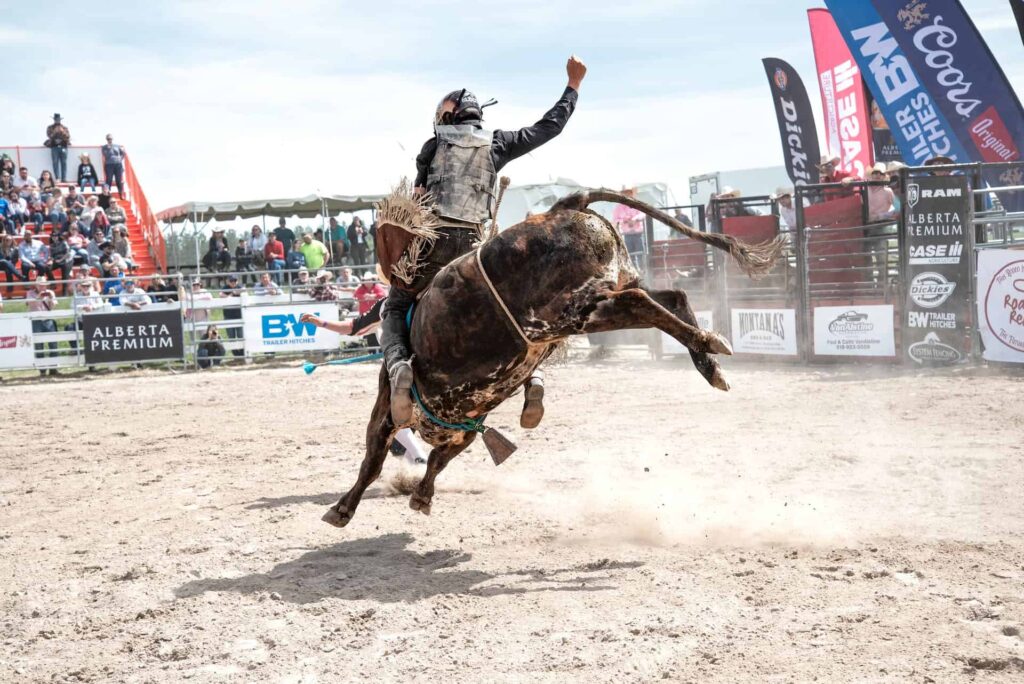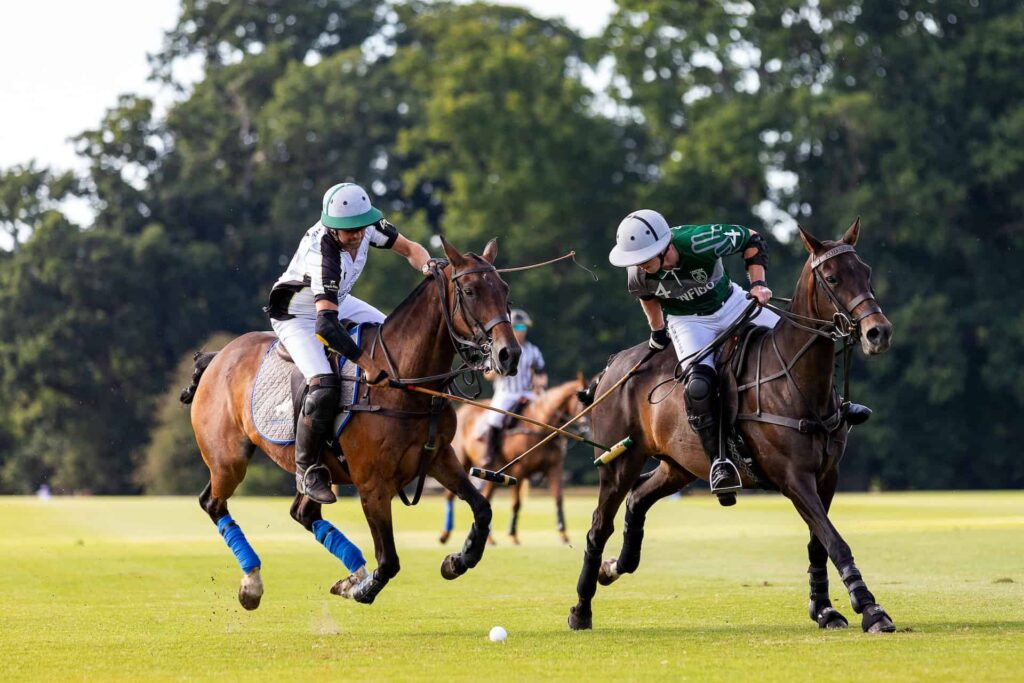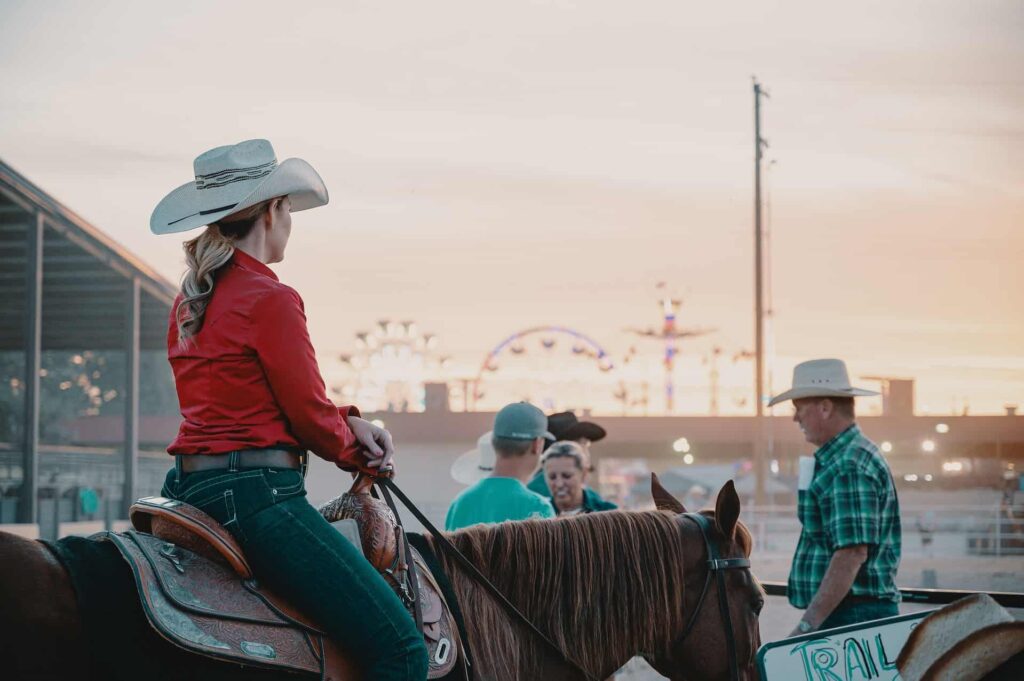Bull riding is a popular and exhilarating rodeo sport with a rich history that dates back to ancient times. Rooted in the culture of ranching and cowboying, this extreme sport has evolved over the years, captivating audiences worldwide with its combination of danger, skill, and raw power. Today, professional bull riding competitions are organized across various countries, showcasing the best bull riders and bulls in the industry.
In a typical bull riding event, competitors must cling onto a massive, bucking bull while attempting to stay on its back for a full eight seconds. The rider’s balance, strength, and agility are put to the test, as they try to avoid being flung off the powerful animal. The sport not only demands physical prowess but also requires mental fortitude, as riders face the ever-present danger of injury. Despite the inherent risks, bull riding continues to grow in popularity, drawing fans from all walks of life who are captivated by its sheer intensity and unpredictability.
Key Takeaways
- Bull riding is an extreme sport with a rich history, enthralling audiences worldwide.
- Competitors must display physical and mental fortitude to succeed in this high-stakes sport.
- The popularity of bull riding continues to rise, thanks to its thrilling and unpredictable nature.
History of Bull Riding
Bull riding has a rich history that can be traced back to various countries and cultures, including Mexico, Brazil, and Australia. It was initially an activity in the Mexican charreada, a predecessor to today’s rodeo. The charreada was an event where riders would show off their skills in horsemanship, roping, and riding bulls.
In the late 1800s and early 1900s, bull riding started gaining popularity in the United States, particularly in the West. It became a part of the Cheyenne Frontier Days event, which showcased cowboys’ skills in roping, bronco riding, and other related activities.
Over time, bull riding expanded to other countries, including Brazil, Australia, Japan, and France. Each country adapted the sport to its unique cultural context, but the core challenge of riding a bucking bull for as long as possible remained the same.
Moving forward, a significant milestone in bull riding history occurred in the early 1990s when a group of riders decided to break away from the traditional rodeo and establish the Professional Bull Riders Inc. (PBR). The PBR helped raise the sport’s visibility and elevate its status, attracting top talent and corporate sponsorships.
Nowadays, bull riding is a well-known and respected sport, with events taking place across the globe. Competitors must be both physically and mentally tough, and exhibits of masculinity play a large role in the performance of riders. As a result, the sport has attracted a devoted fan base, not just in the United States but also in countries where bull riding has taken root.
The history of bull riding reflects its ongoing evolution and globalisation, with its roots in the Mexican charreada and adoption in various countries worldwide. Today, it stands as a testament to the grit, skill, and determination of the riders who brave the challenge of staying on a bucking bull.
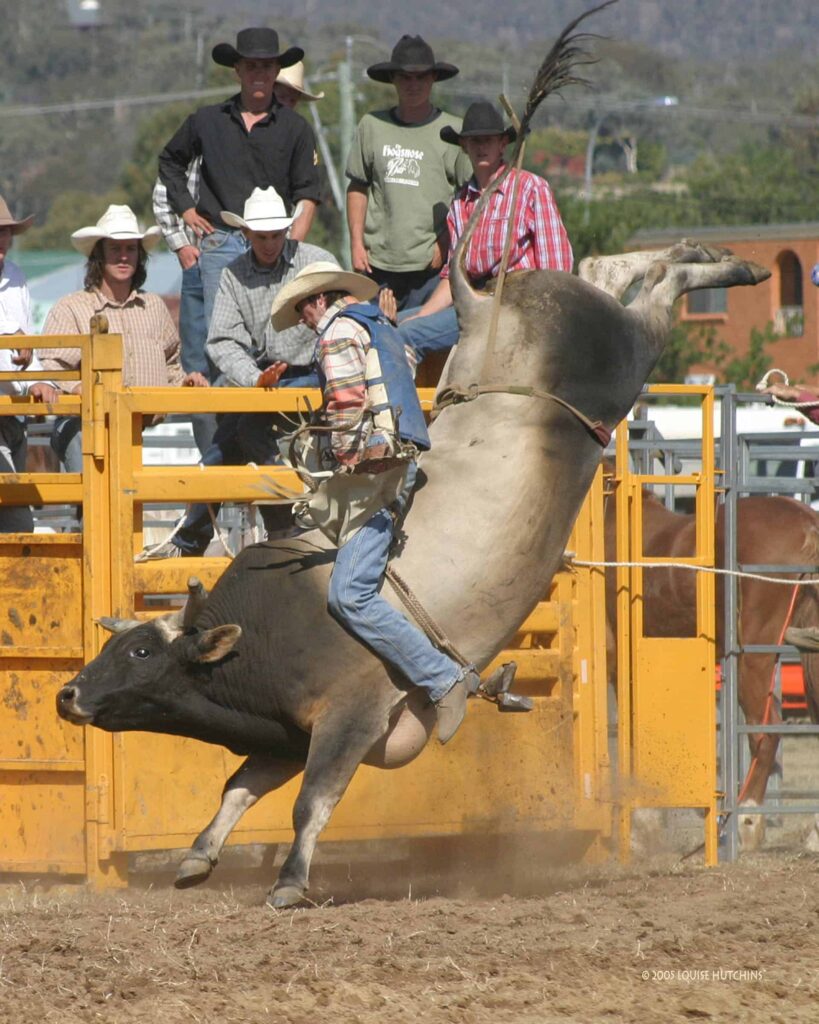
Professional Bull Riding
Professional Bull Riding (PBR) is a highly competitive rodeo sport that has gained immense popularity over the years. PBR was established in 1992 when 21 bull riders invested their own money to create a bull riding-only organization, separate from the Professional Rodeo Cowboys Association (PRCA).
The PBR tour consists of numerous events throughout the year, culminating in the PBR World Finals, which determine the PBR World Champion based on accumulated points. The tour attracts professional riders from various countries, showcasing their skills and abilities in the challenging rodeo sport.
PBR events are not only about the bull riders but also include other participants such as rodeo clowns. Rodeo clowns play a role in ensuring the safety of the riders by distracting the bulls after the riders have been bucked off, thus reducing the risk of serious injuries.
Injuries are a significant concern in professional bull riding, as the sport is inherently dangerous. The data for prevention and care of injuries is critical in this high-risk sport to improve rider safety. Protective gear, including helmets and padded vests, is mandatory for professional bull riders to enhance their protection and minimize the impact of any accidents that may occur during competitions.
The PBR showcases the athleticism and determination of the professional riders, as well as the power and unpredictability of the bulls. It is a thrilling rodeo sport that captivates audiences worldwide with its exciting combination of skill and bravery.
By maintaining its focus on rider safety and expanding the PBR tour worldwide, the organization has solidified its position as a premier rodeo sport, attracting a diverse range of professional riders and fans from different backgrounds, making it a truly global spectacle.
Equipment and Apparel
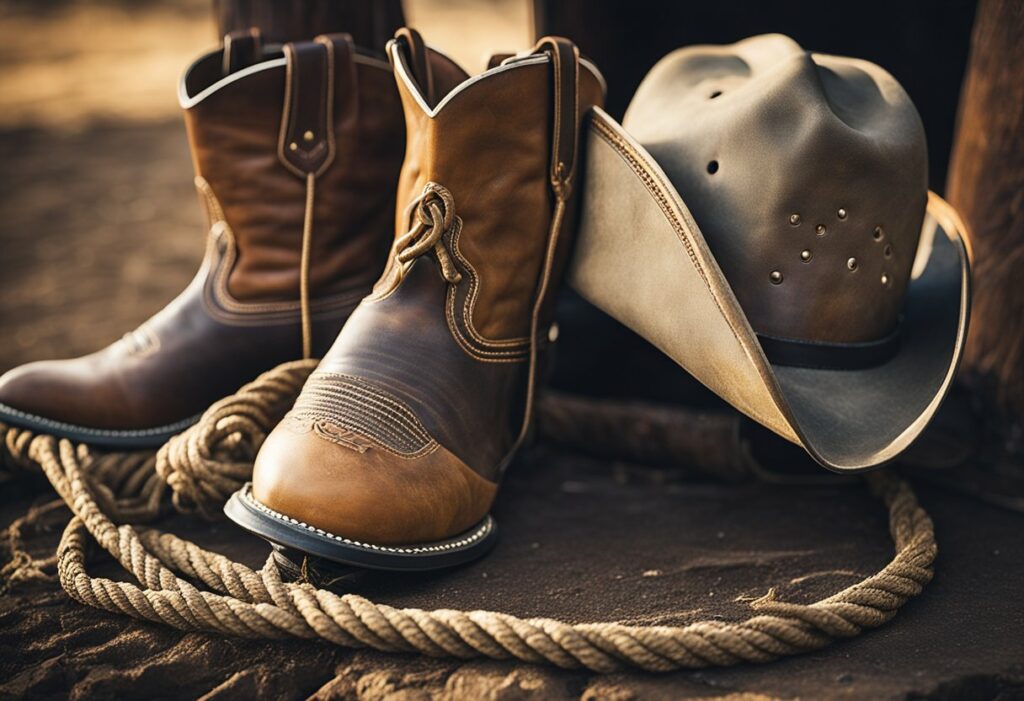
Bull riding is a thrilling and dangerous sport, requiring specialized equipment and apparel that not only ensures the safety of the rider but also enhances their performance. In this section, we will discuss some of the equipment and apparel used in bull riding.
A key piece of equipment is the bull rope. This rope, typically made of braided materials like nylon or poly, is used by the rider to secure their grip on the bull. One end of the rope is wrapped around the bull, while the other end forms a handhold for the rider. Equipment includes the flank strap, which is adjusted around the bull’s belly to encourage bucking without causing harm to the animal.
Safety is paramount in bull riding, and there are several protective items that riders wear. Helmets are necessary for protecting the rider’s head from potential injuries during a fall or collision. Many riders opt for a full-face helmet that offers protection to the face and jaw. Another critical safety gear is the protective vest, often made from high-density foam or other impact-absorbing materials, which shields the rider’s torso from injury in case of a fall or direct collision with the bull.
While maintaining safety, bull riders also require the appropriate apparel to bring comfort and ease of movement. The traditional cowboy hat is worn by many riders, providing sun protection and adding an iconic element to their attire. Riders must be careful that the hat is secure during the ride to prevent it from obstructing vision or becoming a distraction.
Boots are a necessary item for a bull rider, including specialized cowboy boots that offer excellent grip, support, and protection. These boots generally have a smooth sole, a reinforced toe, and a tall heel to enable the rider to secure their feet in the stirrups without slipping.
Chaps are a standard piece of bull riding apparel and are typically made from heavy leather. They serve to protect the rider’s legs from scrapes and bruises while interacting with the bull and during a fall. Chaps may also be customized with various designs or colors, reflecting the rider’s personal style.
The saddle plays a significant role in bull riding even though it is not utilized in the way it is in traditional equestrian sports. The bull riding saddle is specifically designed for the sport and lacks a horn, so the rider does not get caught during a ride or fall.
The specialized equipment and apparel used in bull riding contribute to both the safety and performance of the riders. Ensuring that all gear is well-maintained, correctly fitting, and of high quality is a must for those participating in this exhilarating and perilous sport.
Rules and Scoring
In bull riding, both the rider and the bull contribute to the overall score. The rules and scoring system requires riders to stay mounted on the bull for at least eight seconds, using only one hand to hold onto the rope tied around the animal. The clock starts when the bull’s shoulder or flank breaks the plane of the chute and stops when the rider’s hand comes out of the rope, they touch the ground, or the eight seconds are completed.
Judges play a significant role in scoring the rides. There are typically two judges that evaluate the rider and two that evaluate the bull. Each judge can award up to 25 points for the rider and 25 points for the bull, making a combined total of 100 possible points per ride. The rider’s score is based on their control and ability to counter the movements of the bull, while the bull’s score is determined by the difficulty, agility, and performance during the ride.
Riders must adhere to the rules and regulations of the event. They are not allowed to touch the bull or themselves with their free hand during the eight-second ride, as doing so will result in disqualification. Riders must wear appropriate protective gear such as helmets, gloves, and vests, to increase their safety during the competition.
Ranking in bull riding events depends on the total score earned by the riders. In most cases, the rider with the highest score at the end of the competition takes home the title and prize money. Ties in the final ranking are broken based on the bull’s score, meaning the rider who stays on a more challenging bull will come out on top in case of a tie.
The Bull and the Rider
Bull riding is a thrilling, yet dangerous sport that requires a combination of skill, strength, agility, and balance from both the bull and the rider. As the bull attempts to throw off the rider using powerful bucking movements, the cowboy strives to keep their balance while remaining on the bull’s back.
The rider’s goal is to stay on the bucking bull for a full eight seconds with their free arm extended, waving for balance. This feat requires immense skill and technique, as both the bull’s unpredictable movements and the rider’s ability to adapt and maintain balance contribute to the success or failure of their ride.
One primary aspect of bull riding is the use of spurs, which are attached to the cowboy’s boots. Spurs provide critical grip and support, helping the rider hold onto the bull’s back, especially during quick movements and violent bucks.
It’s not just the rider’s abilities and equipment that matter in bull riding. The bucking bulls play a vital role too. These bulls are specially bred for their aggression, size, and bucking abilities, making them a formidable challenge for any experienced cowboy.
While the rider demonstrates skill, balance, and technique, the bull exhibits an impressive display of power and agility. The surging, spinning, and skirting movements are all designed to unseat the rider, thus highlighting the incredible danger and excitement that comes with participating in this sport.
In addition to the cowboy and the bucking bull, bullfighters also play a critical role in this adrenaline-filled spectacle. As the rider is thrown or chooses to dismount from the bull, bullfighters put their lives on the line to distract the enraged animal and the aid the rider’s safety. Their strength, agility, and quick decision-making skills are key in these high-stakes moments, protecting both the rider and themselves.
The complex and exhilarating dance between the bull and the rider is an unforgettable experience that showcases the incredible skill, strength, and agility of all participants – from the cowboy on the bull’s back, to the agile bullfighters on the ground.
The Ride
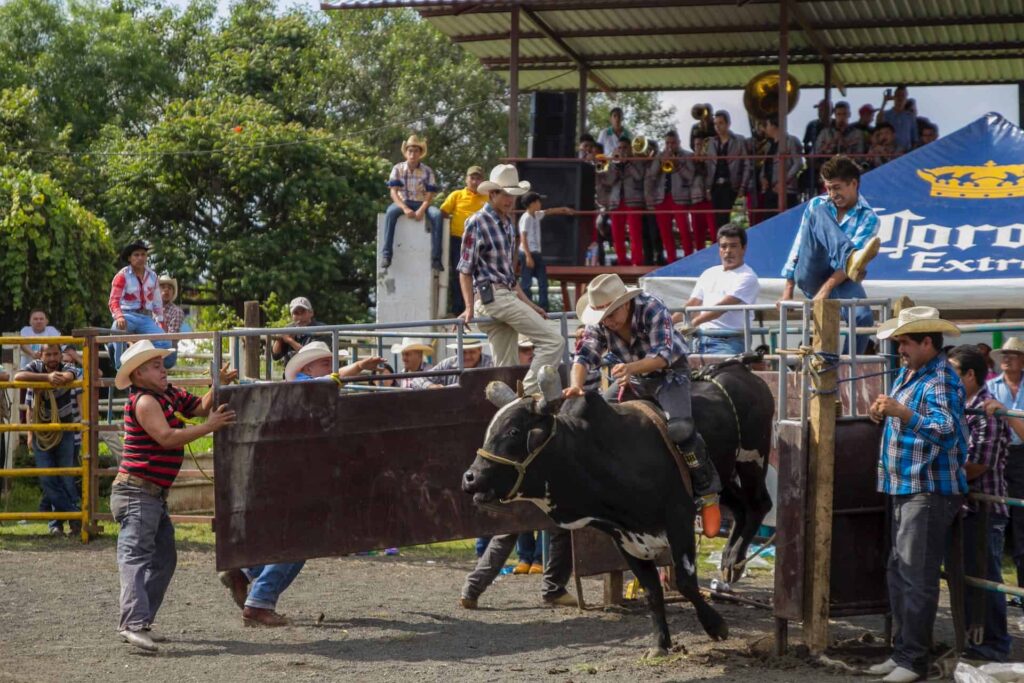
Bull riding is an intense and adrenaline-fueled sport that pushes both the rider and the animal to their limits. The ride begins when the bull is released from the chute, and the rider must hold on with one hand while trying to balance and control the powerful animal beneath them.
An important aspect of bull riding is the eight seconds a rider needs to remain on the bull to qualify for a score. These eight seconds are often referred to as the “dangerous eight seconds” because of the multitude of risks involved. Riders must be in sync with the bull’s unpredictable movements, demonstrating exceptional skill, strength, and agility. A successful ride requires a blend of focus, balance, and courage to control the intense force and action of the bull.
During the ride, riders use their legs to help maintain their grip on the bull. They typically wear spurs, which are metal implements attached to their boots. Spurs are not used to harm the bull but rather to improve the rider’s grip and aid in controlling the bull’s movements. Bull riders need to learn and master the proper technique of using spur aids both for their safety and that of the bull.
The sport of bull riding is dangerous and unforgiving; it’s not uncommon for injuries to occur. Those who participate in this high-stakes sport are passionate and dedicated, continually working to improve their skills to achieve excellence. By considering vital factors like proper equipment, training, and understanding of the risks, riders can navigate the thrilling and treacherous eight seconds of action on the back of a powerful bull.
Remember, bull riding is not for the faint of heart, but for those who embrace the challenge, it can be a rewarding and exhilarating experience.
Competition and Events
Bull riding is an exciting and challenging rodeo event where contestants showcase their skills and courage. In this competitive sport, riders attempt to stay on a bucking bull for 8 seconds while holding onto a rope with one hand. During the competition, riders are judged based on their ability to control the bull and maintain proper riding techniques. An average score is determined, taking into account both the contestant’s performance and the bull’s difficulty.
Rodeo events are held in various settings, from local arenas to large, professional venues. Beyond bull riding, participants can compete in other rodeo disciplines such as barrel racing, where contestants race around barrels in a cloverleaf pattern. These competitions often attract large audiences who enjoy the combination of skill, athleticism, and thrilling performances.
To ensure a fair competition, each bull riding contestant is given multiple tries to achieve the best possible score. The average score of a rider is calculated after all tries have been completed, and the rider with the highest average score is declared the winner. Riders must consistently demonstrate their ability to handle challenging bulls while maintaining proper technique to succeed in this highly competitive sport.
There are different levels of bull riding competitions, ranging from amateur events to professional arenas. At professional events, contestants may belong to organizations like the Professional Bull Riders (PBR), which showcase the world’s top riders and bulls in high-stakes competitions. These events often feature live broadcasts, large prize purses, and global exposure for both riders and the sport of rodeo.
Bull riding competitions and events are a thrilling and captivating aspect of the rodeo world. Participants must demonstrate exceptional skill, courage, and consistency to excel in this demanding sport. From local arenas to professional events, the excitement of bull riding and other rodeo disciplines continues to attract fans and contestants alike.
International Scene
Bull riding has gained popularity not only in the United States but also in various countries around the world. In North America, both Canada and Mexico have embraced this sport and contributed skilled bull riders to the international scene.
In South America, Brazil stands out as a significant player in the bull riding world. A large number of talented Brazilian bull riders participate in competitions worldwide, making them a force to be reckoned with in this sport.
In the Asia-Pacific region, Australia has a flourishing bull riding community. Australian riders have made their presence felt in international events, bringing their unique style and expertise to the forefront.
While not traditionally known for bull riding, European countries like France are gradually developing an interest in this daring sport. Japan is also venturing into the bull riding scene, although it is still in its nascent stages in the country.
Various prestigious events and competitions draw bull riders from all over the globe. Las Vegas serves as host to the Professional Bull Riders (PBR) World Finals, which attracts the most skilled riders from the United States and beyond. Texas is home to multiple bull riding events throughout the year, becoming a hub for enthusiasts and professionals alike.
As the bull riding scene expands internationally, diverse cultures and riding styles come into play, making the sport even more dynamic and exciting for audiences. The ever-growing list of countries engaging in bull riding showcases its increasing appeal and the potential for global growth in the future.
Bull Riding and Popular Culture
Bull riding has experienced a surge in popularity in recent years, transcending its rodeo roots and becoming a significant part of mainstream popular culture. Both celebrities and fans have contributed to this growth, with the sport attracting a diverse and passionate following.
One factor that has brought bull riding into the spotlight is the Professional Bull Riders Inc. (PBR), a governing body that sanctions and oversees bull riding in the United States. The PBR has helped elevate the sport by producing high-quality, well-organized events that draw large crowds and attract media attention.
Celebrities have also played a role in popularizing bull riding. The 1980 film “Urban Cowboy” starring John Travolta introduced many to the world of bull riding and rodeo, sparking a wave of interest in the sport. Since then, celebrities like professional athletes, musicians, and actors have been seen attending and participating in bull riding events, further cementing its status as a mainstream sport.
The appeal of bull riding goes beyond the celebrity endorsement, as the sport’s thrilling nature and intense competition captivate fans from all walks of life. Bull riding events are often packed with adrenaline-fueled performances, making them an exhilarating spectacle for audiences. The athleticism and skill required to successfully ride a bull command respect from both fans and fellow competitors.
Social media has also played a role in spreading the popularity of bull riding. With platforms like Instagram, Facebook, and YouTube, fans can easily follow their favorite riders, learn about upcoming events, and share content with their friends and followers. This digital exposure has helped to further increase the sport’s visibility and reach.
The rise of bull riding in popular culture can be attributed to a variety of factors, including the PBR’s influence, celebrity involvement, the sport’s inherent excitement, and the power of social media. As such, bull riding has earned its place in mainstream entertainment, capturing the imagination of fans and celebrities alike.
Prizes and Rewards
In the world of bull riding, participants often compete for large cash prizes, making it an attractive but dangerous pursuit. The Professional Bull Riders (PBR) circuit, for example, has grown significantly in recent years, with huge television audiences and increased corporate sponsorship contributing to the prize money available.
Prize money in bull riding is typically awarded based on the rider’s performance. The better the rider, the better the payout. For instance, Charles Sampson, a well-known bull rider, managed to take top honors at a major bull riding event, earning a substantial cash prize.
An interesting aspect of bull riding competitions is the use of absolute and relative rewards to encourage team production and individual performance. In some events, heterogeneously endowed individuals are awarded monetary prizes based on their high absolute performance, ensuring that every participant has a chance to win and thus motivating them to perform at their best.
Some events also use rewards or penalties based on an individual’s contributions relative to their teammates. This encourages cooperation within the team while ensuring that individual efforts are duly recognized.
Aspiring bull riders need to keep in mind that while bull riding offers significant rewards, it also poses considerable risks. The pursuit of prize money can often lead to injuries and other consequences, so it’s about the balance ambition with caution.
Related: Horse Sports
Frequently Asked Questions
What are the main rules in bull riding?
In bull riding, the rider attempts to stay on a bucking bull for eight seconds while holding onto a rope with only one hand. The other hand cannot touch the bull or the rider. The rider is judged based on their technique and control, while the bull is judged on its bucking performance. A successful ride scores between one and one hundred points, with higher scores awarded for more difficult bulls and impressive riding skills.
How can I find the PBR schedule for today?
To find the Professional Bull Riders (PBR) schedule for today, you can simply visit their official website, where they post event information, dates, locations, and times. They also share updates on their social media accounts and through their official mobile app.
Where can I buy bull riding tickets?
Bull riding tickets can be purchased from the official PBR website or via recognized ticketing platforms such as Ticketmaster and StubHub. Verify ticket sellers before purchasing to make sure you are getting authentic tickets for the events.
What gear is required for bull riding?
Bull riders wear protective gear including a helmet, protective vest, chaps, and gloves. Additionally, they use a bull rope and a rosin to help maintain their grip during the ride. Boots designed for bull riding can provide ankle support, and spurs may be worn to help the rider maintain control, though they must be dull to avoid injuring the bull.
Is bull riding considered inhumane?
While some critics argue that bull riding can be inhumane due to potential harm to the bull, the rodeo community and governing bodies such as PBR have established strict rules to protect the welfare of the animals. These rules include proper veterinary care, regular inspections of equipment, and measures to prevent mistreatment. Ultimately, the question of whether bull riding is inhumane depends on individual perspectives and beliefs.
How much do professional bull riders earn?
Earnings for professional bull riders can vary widely, with factors like performance, event winnings, and sponsorships influencing their income. Prize money at PBR events can range from a few thousand dollars for lower-ranking riders to millions of dollars in cumulative earnings for top competitors. Sponsorships and endorsements can also provide additional financial support for successful bull riders.
Last Updated on November 1, 2023 by Nate Dewsbury
